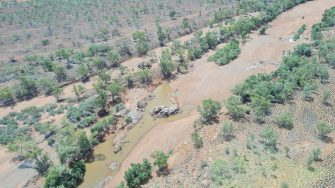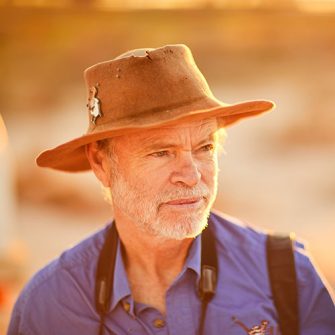
Date: Wednesday October 5th 2022
Project: Eastern Australian Waterbird Survey
Observers: Richard Kingsford & Paul Wainwright
Pilot: Tim Dugan
It was hard to get a taxi or food this morning in Mackay – delaying us more than we hoped. And some of the team were a bit grumpy with the sausage roll fare, only available at the fuel stop.
The big front was well and truly on its way with almost full cloud cover. Still – at least the visibility was good, with the cloud not being too low. So surveying was fine. The cloud cover kept it cooler which is always a blessing on the Band 10 survey day, which has often been oppressively hot.
First survey area was Prosperpine floodplain – with only a few drying lagoons. Nothing like its glory days before the building of the big dam upstream. There were about a hundred magpie geese on one of the dams on the floodplain. The large dam on the Proserpine River was much drier than in previous years. And not the big numbers of ducks that we have seen in the past – reflecting the habitat inland.
On to the Bowen and Burdekin Rivers – one of my favourite bits of the survey.
Burdekin River
It is a fantastically rugged river, with quite a flow coming down this year. We spotted a couple of crocodiles on the banks. On the waterbird front, it was only the odd darter and egret, although there were up to four young sea eagles this year.
Weir on the Burdekin River.
Dam wall on Burdekin River.
Then it was over to survey the massive dam at the top of the river which was full. It has more waterbirds than the river, mainly the fish-eating birds, including the cormorant species, pelicans and Caspian terns. It is still not a highly productive place for waterbirds because it is so deep although its shallow areas were exposed so there were a few hundred ducks using these areas. The dam was well down on its usual capacity, another indicator that not everywhere had been getting the rain.
We landed in Hughenden to refuel and have an early lunch before heading west into the rain. We soon caught up with the front coming our way. Luckily the cloud was reasonably high and visibility was ok.
Rain on our windscreen.
One real bonus was the very pleasant temperature of about 20 deg centigrade which was great for flying, compared to the high thirties which can often happen out here. It meant the usual vicious bumps and heat out here were not part of the day.
With the rain, a small catchment on a creek was running, producing a flash flood.
Most of this land out here remains largely undeveloped apart from some of the large mines but for the first time for a long time there was evidence of land clearing, with trees heaped up to be burnt.
Cleared trees piled for burning.
There was very little water east of Mt Isa, just the odd waterhole, often with a pair of brolgas and some grey teal but not a lot else in terms of waterbirds. Given these systems run with tropical rains, we seldom see much in the way of waterbirds on the way to Mt Isa.
However, most of the waterbirds on this survey band were on Lake Moondara, the water supply for Mt Isa. It always has a few thousand waterbirds and today was no different. There were hundreds of black duck, all the cormorant species, even the odd black-necked stork, white pygmy-geese and both the plumed whistling-duck and wandering whistling-duck. There were also a lot of grey teal and pelicans.
Water levels were very low with capacity only at about 32%, reflecting that the Mt Isa has not seen the same extent of run-off with La Nĩna that other parts have experienced.
Lake Moondara.

